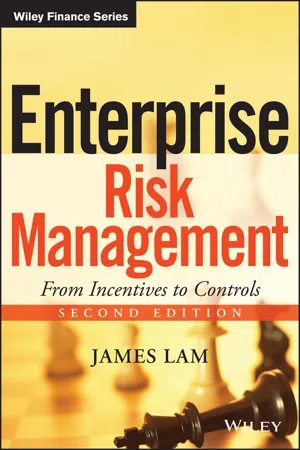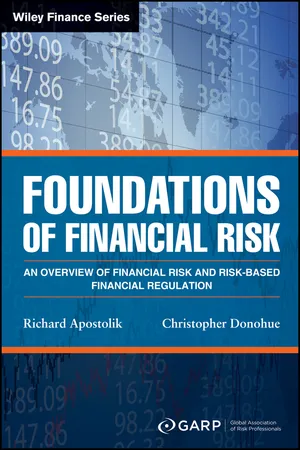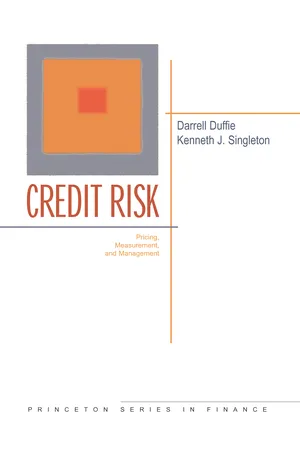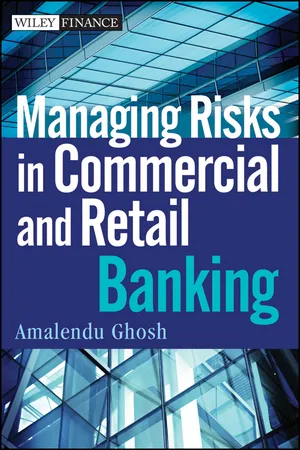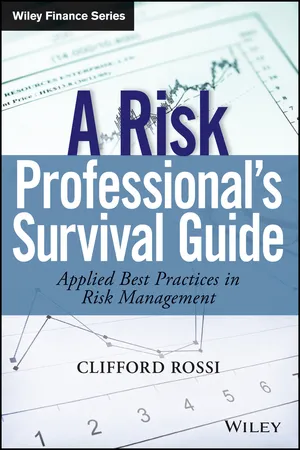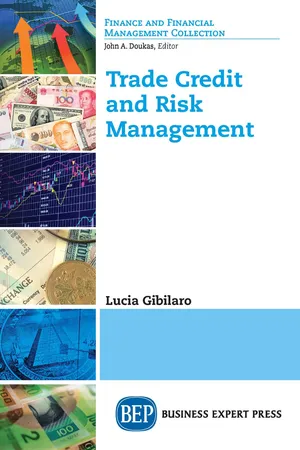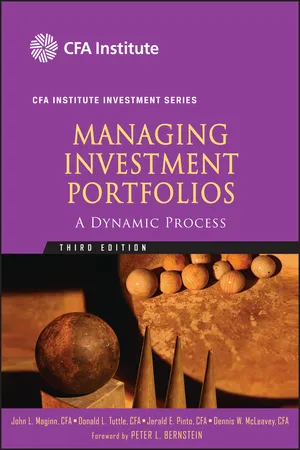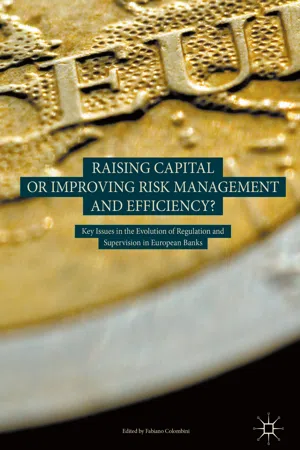Economics
Credit Risk Management
Credit risk management refers to the process of assessing, mitigating, and monitoring the potential for borrowers to default on their financial obligations. It involves evaluating the creditworthiness of borrowers, setting appropriate credit limits, and implementing strategies to minimize the risk of financial loss due to default. Effective credit risk management is crucial for maintaining the stability and profitability of financial institutions.
Written by Perlego with AI-assistance
Related key terms
9 Key excerpts on "Credit Risk Management"
- eBook - ePub
Enterprise Risk Management
From Incentives to Controls
- James Lam(Author)
- 2014(Publication Date)
- Wiley(Publisher)
It is important to note that a company does not necessarily need to establish best practices for all of its risk management areas. The appropriate level of sophistication in risk management processes really depends on the risk profile of the individual company. For example, a manufacturing company does not require the same level of investment in Credit Risk Management as a commercial bank. Therefore, many companies have adopted what they considered to be best-in-class practices that incorporate the size, complexity, and risk profile of their businesses.Basic PracticeA fundamental step in Credit Risk Management is developing common definitions of risk and exposure measurement across business units. These definitions include items such as counterparty names used to identify the legal entities involved and the associated credit exposures; risk ratings, based on consistent underwriting standards; and simple exposure measurement and aggregation methodologies such as loan and notional amounts. At the basic practice level, few risk ratings are established, and those that are installed are mainly used to accept or decline credits. The majority of credit exposures are often lumped into two or so ratings. The use of credit limits are focused on individual transactions, such as maximum amounts by obligor and risk rating, with few, if any, portfolio risk limits. The use of credit risk models is limited to simple spreadsheet models, ratio analysis, and credit bureau reports.The Credit Risk Management function is mainly a credit policy, approval, and monitoring function. It establishes credit policies and underwriting guidelines on how credits should be rated and what ratings are acceptable. Approval by a credit analyst or committee is only required for transactions above a certain size. On an ongoing basis, the credit function also identifies problem loans, maintains a watch list, and plays a central role in the workout process. The performance of the credit risk function is mainly determined by the level of charge-offs and delinquent loans. - eBook - ePub
Foundations of Financial Risk
An Overview of Financial Risk and Risk-based Financial Regulation
- Richard Apostolik, Christopher Donohue(Authors)
- 2015(Publication Date)
- Wiley(Publisher)
Chapter 5 takes a deeper look at how banks manage credit risk, starting with portfolio risks and credit exposure. Credit portfolio modeling is complex, and while some banks do build their own models, most use commercially available models; Section 5.3 provides a brief description of such tools. Credit monitoring was described in Chapter 4 in Section 4.6 on the credit process, but it features here again along with early warning signals, given their important role in the management of the portfolio credit risk profile. Section 5.8 explains remedial management and provides a framework of next steps in the event of distressed loans. The final section discusses the Basel III Accord's guidelines to measure and manage credit risk.Chapter Outline- 5.1 Portfolio Management
- 5.2 Techniques to Reduce Portfolio Risk
- 5.3 Portfolio Credit Risk Models
- 5.4 Credit Monitoring
- 5.5 Credit Rating Agencies
- 5.6 Alternative Credit Risk Assessment Tools
- 5.7 Early Warning Signals
- 5.8 Remedial Management
- 5.9 Managing Default
- 5.10 Practical Implications of the Default Process
- 5.11 Credit Risk and the Basel Accords
Key Learning Points- Portfolio management involves determining the contents and the structure of the portfolio, monitoring its performance, making any changes, and deciding which assets to acquire and which assets to divest.
- Key portfolio risks are concentration risk, correlation risk, and contagion risk.
- Banks use various techniques to reduce the overall risk of their loan portfolios.
- Effective credit monitoring is an important part of the credit process and enables a bank to recognize changes in the creditworthiness of credits within the portfolio and to minimize migration risk.
- Credit rating agencies provide independent credit assessments, which can be used to independently verify a counterparty's creditworthiness and also to monitor credit.
- Market-derived ratings can identify where market sentiment may differ from an internal or external credit rating and may indicate a warning signal to a portfolio manager.
- Portfolio managers should learn to recognize the signals of increasing default risk.
- eBook - ePub
Princeton Series in Finance
Pricing, Measurement, and Management
- Darrell Duffie, Kenneth J. Singleton(Authors)
- 2012(Publication Date)
- Princeton University Press(Publisher)
2
Economic Principles of Risk Management
WHY DO MANAGERS of financial institutions care about financial risks? Are the economic incentives for managing market and credit risks the same, or does credit risk present different challenges, calling for distinct measurement systems or tools? These are some of the questions that we begin to address in this chapter. The economics of risk management for financial firms is far from an exact science. While rigorous and empirically testable models can be brought to the task of measuring financial risks, some of the benefits and costs of bearing these risks are difficult to quantify.In a hypothetical world of perfect capital markets—as we know from the work of Modigliani and Miller (1958), widely held to be the basis for the Nobel prizes awarded to Franco Modigliani and Merton Miller—any purely financial transaction by a publicly traded firm has no impact on that firm’s total market value. Capital markets, however, are not perfect. Market imperfections underlie significant benefits for banks and other financial institutions for bearing and controlling financial risks. Indeed, we name and characterize many of these benefits. One should not, however, anticipate a model allowing a practical cost-benefit analysis of risk that leads to precise quantitative trade-offs. Some of the important channels through which risk operates to the detriment or benefit of a financial corporation are not readily priced in the market.For instance, there are no obvious formulas to determine the market value that can be created by a financial firm willing to bear a given amount of risk through proprietary trading or intermediation. In perfect capital markets, after all, securities are priced at their fair market values, and trading could therefore neither add nor subtract market value. Any such formula relating financial risk bearing to the market value of the firm would, in the reality of imperfect capital markets, depend on such difficult-to-capture variables as the human abilities of traders and management, the information flows available to the firm, its reputation, its access to customers, and its organization of the risk-management function itself, not to mention a host of economic variables that characterize its economic environment. - eBook - ePub
- Brian W. Clarke(Author)
- 2018(Publication Date)
- Routledge(Publisher)
Assessment and Management of Credit RisksPassage contains an image
Burt Edwards (with contributions by Brian W Clarke)CHAPTER FIVE The Range of RisksObviously, companies expect to be paid when they sell on credit terms. Yet most companies write off some sales as uncollectable and suffer payment delays beyond agreed credit terms. These risks, and others, severely deplete net profits. Sometimes they cause sellers to close down or be sold off. This is a particular risk for those companies engaged in international trade.Credit management means the proper care of a company's largest and riskiest asset - accounts receivable, or trade debtors. At risk of erosion from the passage of time and unplanned events, receivables are the fragile provider of all the company's cash. Profit comes only from cash, so the events which delay or prevent receivables turning into cash need management at a senior level.Sadly, many companies just sell and wait to be paid. Most of the company failures of recent years have been those which concentrated on sales priorities, neglected their asset management and ran out of liquidity as a result. Successful companies know the importance of cash and pay adequate top-level attention to its fast generation. Their careful management of the business certainly includes the due diligence of identifying and managing credit risks.The Real Cost of Credit
In selling on credit terms, profit leakage must be minimized. Prices may include an assumed cost of the credit term, calculated at the seller's cost of money. But there are other costs which, if not avoided, must either be passed on to customers or absorbed by the seller via a reduction in the net profit before tax. - eBook - ePub
- Amalendu Ghosh(Author)
- 2012(Publication Date)
- Wiley(Publisher)
www.bis.org .3. “Principles for the Management of Credit Risk,” BCBS, September 2000.Passage contains an image CHAPTER 7 Identification of Credit Risk 7.1 MARKET RISK AND CREDIT RISK RELATIONSHIP
Volatility in market risk factors, like changes in interest rates and exchange rates, generates credit risk, as was clearly evident during the Asian financial crisis of 1997 to 1998. The debt burden of the banks’ clients, who had obtained foreign currency loans, increased substantially in terms of the domestic currency when the exchange rates depreciated appreciably, which led to large-scale credit defaults that resulted in the financial crisis. The credit risk of banks increased substantially due to the increase in interest rates and depreciation in the exchange rate.Credit risk denotes the probability of default in meeting financial commitments, and market risk denotes the possibility of erosion in the value of assets or earnings. Between credit and market risks, it is not possible to say with certainty which has relatively greater impact on banks. It largely depends on the asset composition, the macroeconomic condition of the economy, the volatility of the financial and capital markets, and the overall operational environment. Where loans and advances constitute a significant portion of the balance sheet, and the operating environment is not conducive to the development of sound business, and the legal system in support of the lender is weak, the intensity of credit risk is likely to be of a larger magnitude.There are certain distinguishing characteristics between credit and market risks that reveal their true nature. First, credit risk usually lasts longer than market risk because it is difficult for banks to liquidate loan assets at their option, while there are established markets for selling investment assets. The exit route for investments is far easier than that for loans and advances. Credit risk continues till the relationship with the borrower is terminated. This is more so, because credit exposures to customers take place in various forms, and one or the other exposure continues to exist for a long time. - eBook - ePub
A Risk Professional�s Survival Guide
Applied Best Practices in Risk Management
- Clifford Rossi(Author)
- 2014(Publication Date)
- Wiley(Publisher)
CHAPTER 2 Overview of Financial Risk ManagementRISK MANAGEMENT DEFINED
Risk management describes a collection of activities to identify, measure, and ultimately manage a set of risks. People and organizations confront risks every day: For example, an individual decides to leave a relatively secure job for another with better opportunity and compensation across country, a government faces the threat of terrorist attacks on public transportation, or a bank determines which financial products it should offer to customers. While some risks are fairly mundane and others a matter of life or death at times, the fundamental process for assessing risk entails evaluation of trade-offs of outcomes depending on the course of action taken. The complexity of the risk assessment is a function of the potential impact from a particular set of outcomes; the individual deciding to take a different job is likely to engage in a simpler risk assessment, perhaps drawing up a pros and cons template, while a government facing terrorist threats might establish a rigorous set of quantitative and surveillance tools to gather intelligence and assign likelihoods and possible effects to a range of outcomes.Regardless of the application or circumstance, each of the assessments above has a common thread, namely, the assessment of risk. But what exactly is risk and is it the same across all of these situations? Risk is fundamentally about quantifying the unknown. Uncertainty by its very nature tends to complicate our thinking about risk because we cannot touch or see it although it is all around us. As human beings have advanced in their application of technology and science to problem solving, a natural evolution to assessing risk using such capabilities has taken place over time. Quantifying uncertainty has taken the discipline of institutional risk management to a new level over the past few decades with the acceleration in computing hardware and software and analytical techniques. - eBook - ePub
- Lucia Gibilaro(Author)
- 2018(Publication Date)
- Business Expert Press(Publisher)
CHAPTER 1 Risk Management for Trade Credit Financing Instruments IntroductionThe risk mitigation of trade credits reflects the implementation of the Credit Risk Management system by ensuring the convergence between the underlying risk exposure and the capital planning of the financiers. Given equal trade credits, exposure to credit risk depends on the legal characteristics of the transaction and the services offered, while risk mitigation depends on the credit risk embedded in the assets. Therefore, alternatives to the implementation of an internal rating system distinguish between exposures based on purchased and/or assigned trade receivables (see An Internal Rating System for Exposures Based on Purchased/Assigned Trade Receivables section) and exposures backed by trade receivables (see An Internal Rating System for Exposures Backed by Trade Receivables section). Once the conceptual framework for the implementation of the internal rating system is defined (see An Internal Rating System for Trade Credit Financing Instruments section), the specific characteristics of the lending activity require adaptations in the application of the standard credit risk measurement parameters at both the individual level (see Credit Risk Parameters: Theoretical Features and Empirical Evidence section) and portfolio level (see Concentration Risk: Alternative Approaches and Empirical Evidence section). Concluding remarks are presented in Conclusions section.Trade Credit Financing and Credit Risk ExposureThe potential loss that a financier can incur in lending to a defaulted debtor is determined by the exposure to credit risk. Therefore, credit risk models must provide consistent estimations (Crouhy, Galai, and Mark 2000). Exposure to credit risk depends on the types of products (Araten and Jacobs 2001), and predictability is strictly affected by the relevance of the undrawn amount of the commitment (Asarnow and Marker 1995). - eBook - ePub
Managing Investment Portfolios
A Dynamic Process
- John L. Maginn, Donald L. Tuttle, Dennis W. McLeavey, Jerald E. Pinto, John L. Maginn, Donald L. Tuttle, Jerald E. Pinto, Dennis W. McLeavey(Authors)
- 2010(Publication Date)
- Wiley(Publisher)
factor push, the basic idea of which to is to push the prices and risk factors of an underlying model in the most disadvantageous way and to work out the combined effect on the portfolio’s value. This exercise might be appropriate for a wide range of models, including option-pricing models such as Black-Scholes-Merton, multifactor equity risk models, and term structure factor models. But factor push also has its limitations and difficulties—principally the enormous model risk that occurs in assuming the underlying model will function in an extreme risk climate.Other approaches include maximum loss optimization—in which we would try to optimize mathematically the risk variable that will produce the maximum loss—and worst-case scenario analysis—in which we can examine the worst case that we actually expect to occur.Overall stress testing is a valuable complement to VaR analysis and can highlight weaknesses in risk management procedures.5.6. Measuring Credit Risk
Credit risk is present when there is a positive probability that one party owing money to another will renege on the obligation (i.e., the counterparty could default). If the defaulting party has insufficient resources to cover the loss or the creditor cannot impose a claim on any assets the debtor has that are unrelated to the line of business in which the credit was extended, the creditor can suffer a loss.515 A creditor might be able to recover some of the loss, perhaps by having the debtor sell assets and pay the creditors a portion of their claim.Credit losses have two dimensions: the likelihood of loss and the associated amount of loss (reflecting, of course, the amount of credit outstanding and the associated recovery rate). The likelihood of loss is a probabilistic concept: In every credit-based transaction, a given probability exists that the debtor will default. When a default does occur, however, creditors are often able to recover at least a portion of their investment, and as such, it is necessary and appropriate to assess the magnitude of this recovery (i.e., the recovery rate) in order to fully understand the risk profile of the credit dynamic. In relation to data on market risk, the amount of information available on credit losses is much smaller. Credit losses occur infrequently, and as such, the empirical data set from which to draw exposure inferences is quite limited. Although some statistical data are available, historical recovery rates can be unreliable. It can be hard to predict what an asset could be sold for in bankruptcy proceedings, and claims are not always paid in the order specified by bankruptcy law. - eBook - ePub
Raising Capital or Improving Risk Management and Efficiency?
Key Issues in the Evolution of Regulation and Supervision in European Banks
- Fabiano Colombini, Fabiano Colombini(Authors)
- 2018(Publication Date)
- Palgrave Macmillan(Publisher)
liquidity produce, respectively, positive or negative reflexes on the granting of credit.3.3 Credit Risk: Measurement and Management
Credit risk is the risk of potential default of borrowers in the repayment of debt as principal and as interest. This is a very powerful risk as it can produce negative impacts and losses which will cause reductions in asset values and write-downs in loans’ portfolios and therefore in the level of capital. In this framework, the analysis considers credit risk essentially with application to loans’ portfolios.More generally, credit risk appreciation can be carried out by the analysis of the following parameters: probability of default (PD) , loss given default (LGD ), exposure at default (EAD ), maturity (M ).PD , which is expressed in percentage terms, represents the probability of client insolvency within a year and oscillates between 0 and 1. LGD expressed in percentage terms quantifies the loss that would occur in the case of client insolvency. EAD measures the level of exposure at the time of client default. M concerns the maturity of loans granted to clients. Taking these different parameters into consideration, the bank can formulate precise credit risk assessments on clients’ loan portfolio . PD , together with LGD and EAD , constitutes an assessment of the credit risk. Therefore, a rise in credit risk is accompanied by an increase in the credit rate applied.Credit risk may give rise to expected loss (EL ) which does not create problems for the bank as appropriate accounting provisions are always made. Therefore, the bank will not undergo any negative impact that would affect future profits. In contrast, if credit risk is unforeseen, this may cause unexpected loss (UL
Index pages curate the most relevant extracts from our library of academic textbooks. They’ve been created using an in-house natural language model (NLM), each adding context and meaning to key research topics.
